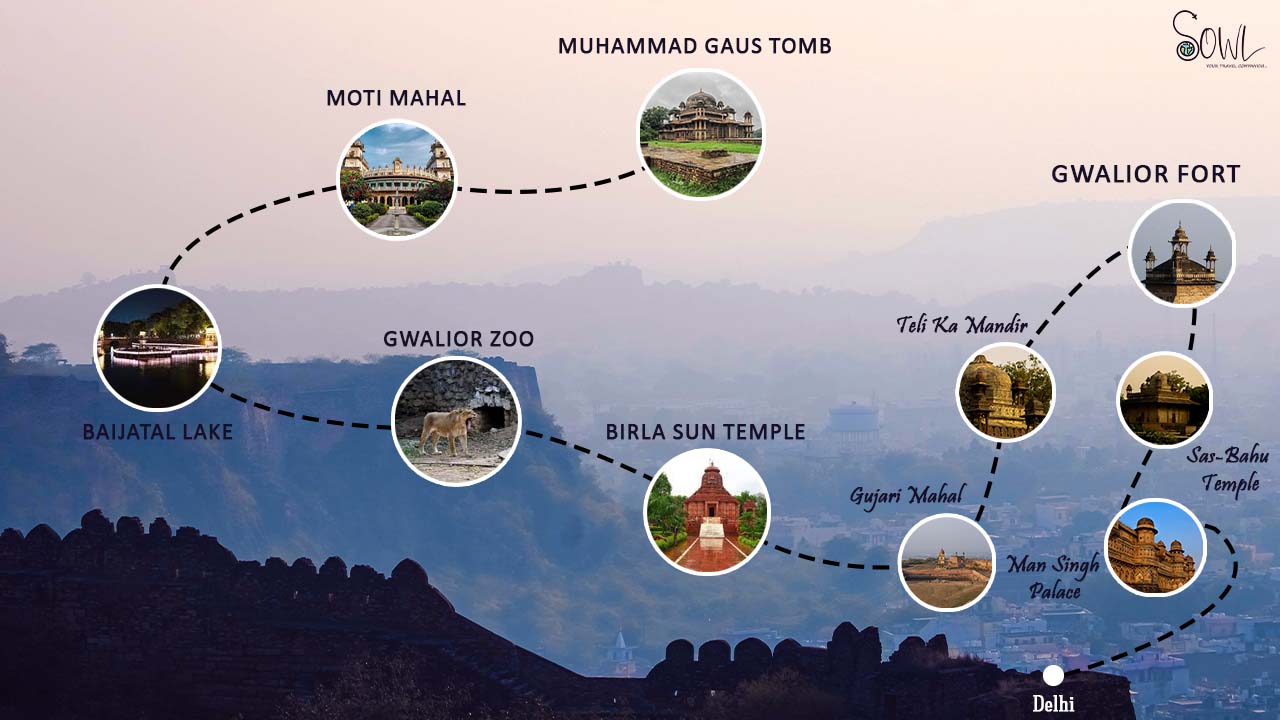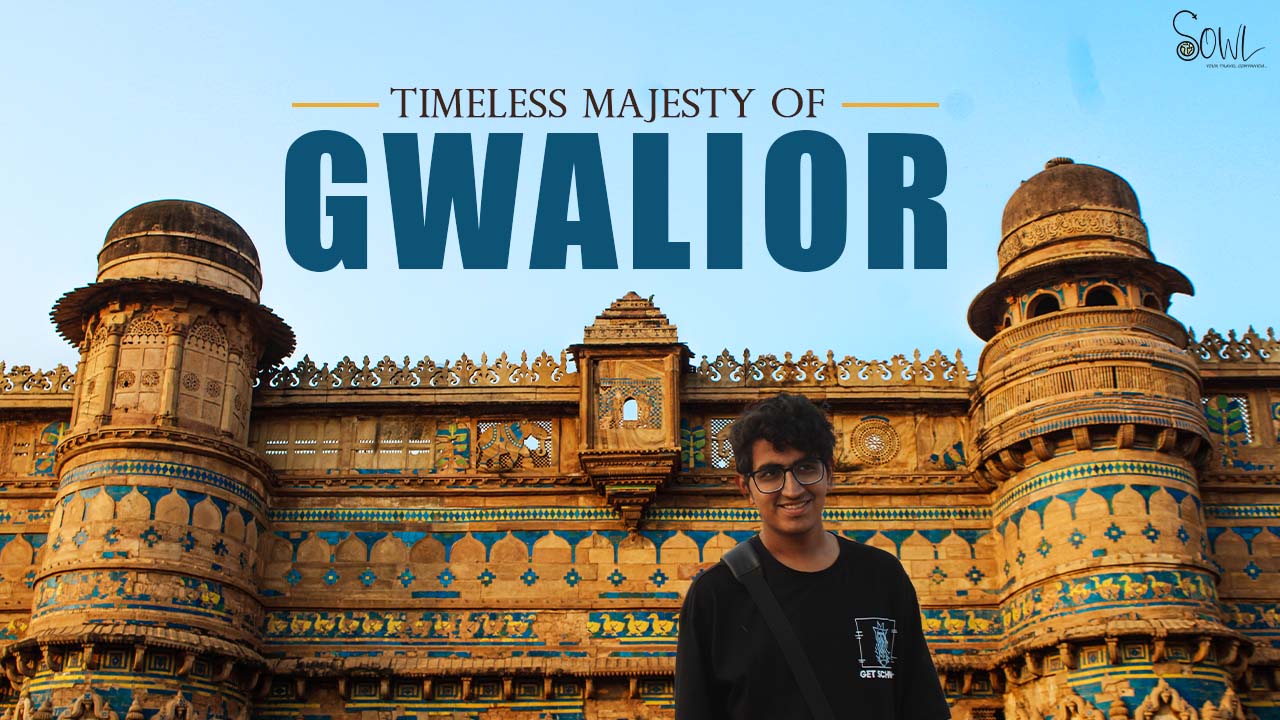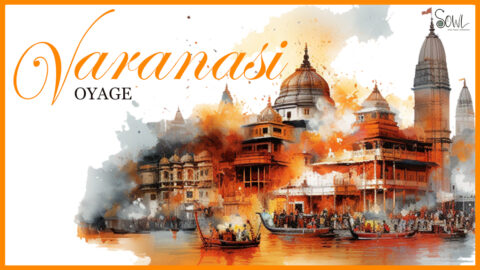Hello, my travel lovers! Kartikeya Mishra is here!!!
A seven-hour drive from the capital city of Delhi, Gwalior stands as one of my favourite places to visit. Also, filled with the timeless architectural marvels of different dynasties, it feels like you have come to a modern historical era.

Exploring the Gwalior route from Delhi:
Gwalior is a city nestled between Morena and Jhansi, conveniently located for travellers coming from Delhi or Bhopal. It’s about a seven-hour drive or a four-hour train journey from both cities. Also, several trains connect Gwalior to major stations like VGLJ, NDLS, Hazrat Nizamuddin, and even Old Faridabad, which we opted for.
The journey from Old Faridabad takes around six hours, and you can choose between an AC coach, CC, or 2S class based on your preference. The Taj Express offers various coach options and convenient timings, making it a great choice for travel to Gwalior.
Must-See Destinations in the Heart of Gwalior
1. Gwalior Fort
Standing at the city’s top and having a remarkable skyline dating back to the 8th century, the fort’s construction is attributed to various rulers over the centuries, making it a site of diverse architectural and cultural influences.
The fort is built on a solitary, rocky hill called Gopachal Parvat, overlooking the city of Gwalior. Also, its towering walls and imposing structures are a testament to the ingenuity of ancient Indian architecture.
The fort complex includes several notable structures:
- Man Singh Palace: Also known as the Man Mandir Palace, was built by Raja Man Singh Tomar in the 15th century and is famous for its ornate blue tiles and intricate carvings.
- Gujari Mahal: Constructed by Raja Man Singh for his beloved queen Mrignayani, it now houses an archaeological museum.
- Sas-Bahu Temple: A 9th-century temple complex dedicated to Vishnu, known for its breathtaking sculptures and carvings.
- Teli Ka Mandir: The tallest and oldest structure within the fort, this temple showcases a blend of North and South Indian architectural styles.
- Gwalior Gate: The main entrance to the fort, showcases robust defensive structures designed to protect the fort from invaders.
Also, the camera charges are around 250/-, so either get the ticket or skip taking it out in Gujari Mahal. You can use it on the fort.
2. Birla Sun Temple
The Birla Sun Temple, constructed in the 1980s, draws inspiration from the majestic Konark Sun Temple. Also, the temple grounds are serene and well-maintained. Remember, cameras and mobile phones aren’t permitted inside. Moreover, the temple’s interiors are truly splendid and worth a visit.
3. Gwalior Zoo
Situated about 2 kilometres from the Gwalior Railway Station, the zoo is worth a visit. For approximately an hour, the zoo is home to many different species of animals and birds. Also, the entry charges are very minimal. Extra charges for the camera.
4. Baijatal Lake
At a walking distance from the zoo, Baijatal is a very peaceful spot to spend your time in the tree shade in the chhatris. Dome-like structures surround the lake, where you can sit and have photoshoots. Also, there is a boating facility to roam around in the lake. You can go here for photo and video shoots.
5. Moti Mahal
Just opposite Baijatal, Moti Mahal stands. With a very minimal fee of Rs. 20, it is a 30-minute visit.Also, a small palace with a view of Baijatal and beautiful interiors surely mesmerises you.
6. Muhammad Gaus Tomb
An architectural edifice, the tomb was built somewhere in the 1560s after Muhammad Ghaus’s death. Also, the campus has the tombs of Muhammad Ghaus and Tansen, among many others. There is no entry fee. Moreover, the whole premise is usually very quiet and a peaceful spot to spend your afternoon. Also, it has nice architecture and is good for photography and urban sketching.
A hidden gem in Gwalior:
Discover some hidden gems during your stay! Venture to the serene Tighra Dam, where tranquil waters and scenic views await. Also, explore the majestic City Palace, a treasure trove of history and architectural marvels. Also, don’t miss the enchanting Gopachal Parvat, a sanctuary of spirituality nestled amidst nature’s beauty.
Gourmet Delights and Accommodation in Gwalior :
We booked retiring rooms from IRCTC for our stay. Prices range from Rs. 2500 per room, depending on the type. Also, the rooms are spacious and pleasant. Moreover, you can book them easily through the IRCTC website. Likewise, there are also plenty of nearby hotels that offer affordable and comfortable accommodations.
Some restaurants and cafes you can try are
1. Indian Coffee House
2. Fast food chains in DB Mall, just opposite the station
3. Pohe near the railway station
4. Morena ke Gajak
Also, the local shops selling fast food are also really nice, so make sure to try them out.
The best time to visit Gwalior:
Gwalior is a city that welcomes visitors year-round, but the ideal time to explore is from September to March. Also, the weather during these months is pleasant, perfect for sightseeing. Also, if you enjoy a bit of rain, July to September is also a good time to experience the city’s charm.
Travel tips for Gwalior:
- The autos are comparatively cheaper as compared to other cities, 10–25 per person for all the above-mentioned locations from the railway station.
- Also, try going to the fort either in the morning hours or 120 minutes before sunset.
- Travel in groups.
- Moreover, have a good sleep before travelling.
- Likewise, keep medicines in hand, especially if you have motion sickness.
Gwalior has a unique charm, blending its rich history with modern life. Also, the locals are incredibly friendly and willing to share stories about the city and its illustrious past, including insights into the Scindias and its people. Moreover, spending a day or two in Gwalior is worthwhile.
Embark on a journey through captivating travel sagas at https://sowl.in/stories/ and experience the world!





















